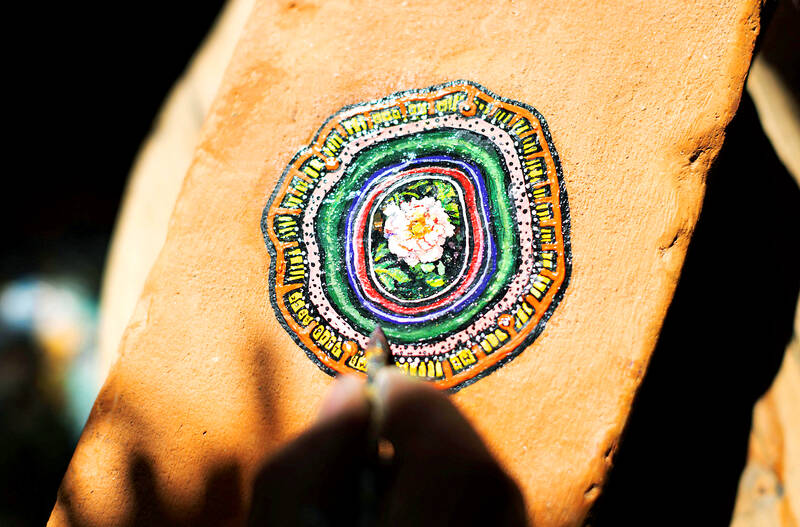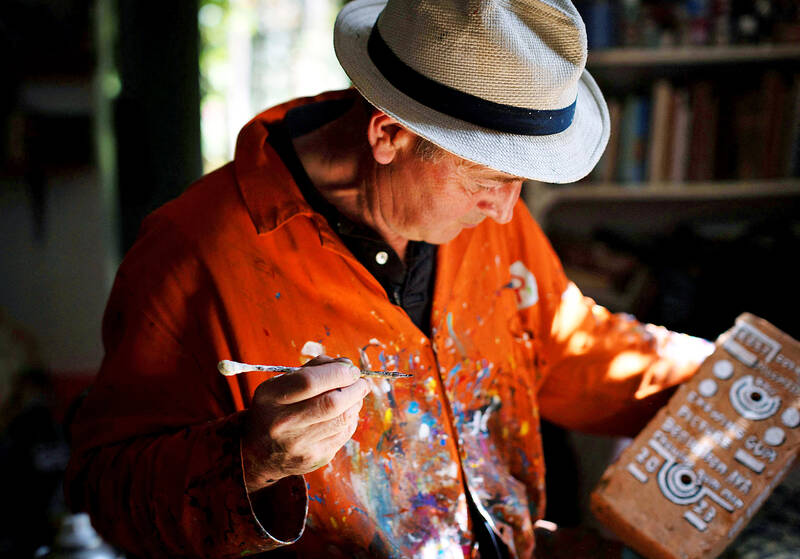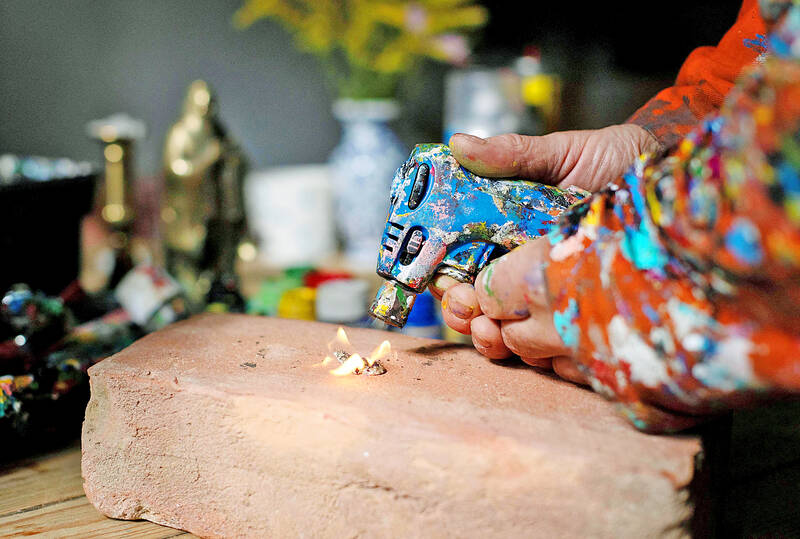Lying on his side on the surface of London’s iconic Millennium Bridge, artist Ben Wilson paints a piece of dried chewing gum trodden into the ground.
“The important thing is the gum is below the metal tread,” said 60-year-old Wilson, dressed in a paint-daubed orange jumpsuit. “The beauty of it is they’re all different shapes and sizes so there’s no conformity.”
What most people actively avoid or simply don’t see, Wilson views as an opportunity to turn a tiny piece of discarded rubbish into something beautiful. It’s also a way to delight passersby, enticing them to take a closer look underfoot.

Photo: Reuters
“By painting a picture which is so small, those that see it then discover a hidden world beneath their feet,” Wilson said.
“If they look then they see, so it’s about perception.”
Back in his north London studio, Wilson paints on the surface of a small mosaic tile which will be part of a collection that he sticks on the walls of London’s Underground train platforms, hidden in plain sight. The images are more personal than the chewing gum works, Wilson says, and represent

Photo: Reuters
an “intuitive visual diary.”
“The pictures are a celebration of my life and those that I care dearly about ... they are (also) a process of visual inquiry — trying to make sense of the world,” he said.
London-born Wilson was raised by artist parents and recalls working with clay from age three, with his first artist show at around 10 or 11 years old.

Photo: Reuters
His artwork developed into sculpture and large pieces in the natural environment before his interest turned to rubbish and discarded items from a consumerist world, like chewing gum, which he’s been painting for 19 years.
The top surface of the dried gum is not subject to local or national jurisdictions, creating a space where Wilson says he can paint without defacing public property.
“I found this little space where I could create a form of art where I could be spontaneous and do something which evolves out of the place in which it’s created,” Wilson said.
The artist has had much of his public street art removed by authorities — gum from the pavement or tiles from the Underground — but the hundreds of gum paintings on Millennium Bridge have been left untouched.

“Why does Taiwan identity decline?”a group of researchers lead by University of Nevada political scientist Austin Wang (王宏恩) asked in a recent paper. After all, it is not difficult to explain the rise in Taiwanese identity after the early 1990s. But no model predicted its decline during the 2016-2018 period, they say. After testing various alternative explanations, Wang et al argue that the fall-off in Taiwanese identity during that period is related to voter hedging based on the performance of the Democratic Progressive Party (DPP). Since the DPP is perceived as the guardian of Taiwan identity, when it performs well,

The Taiwan People’s Party (TPP) on May 18 held a rally in Taichung to mark the anniversary of President William Lai’s (賴清德) inauguration on May 20. The title of the rally could be loosely translated to “May 18 recall fraudulent goods” (518退貨ㄌㄨㄚˋ!). Unlike in English, where the terms are the same, “recall” (退貨) in this context refers to product recalls due to damaged, defective or fraudulent merchandise, not the political recalls (罷免) currently dominating the headlines. I attended the rally to determine if the impression was correct that the TPP under party Chairman Huang Kuo-Chang (黃國昌) had little of a

At Computex 2025, Nvidia CEO Jensen Huang (黃仁勳) urged the government to subsidize AI. “All schools in Taiwan must integrate AI into their curricula,” he declared. A few months earlier, he said, “If I were a student today, I’d immediately start using tools like ChatGPT, Gemini Pro and Grok to learn, write and accelerate my thinking.” Huang sees the AI-bullet train leaving the station. And as one of its drivers, he’s worried about youth not getting on board — bad for their careers, and bad for his workforce. As a semiconductor supply-chain powerhouse and AI hub wannabe, Taiwan is seeing

Jade Mountain (玉山) — Taiwan’s highest peak — is the ultimate goal for those attempting a through-hike of the Mountains to Sea National Greenway (山海圳國家綠道), and that’s precisely where we’re headed in this final installment of a quartet of articles covering the Greenway. Picking up the trail at the Tsou tribal villages of Dabang and Tefuye, it’s worth stocking up on provisions before setting off, since — aside from the scant offerings available on the mountain’s Dongpu Lodge (東埔山莊) and Paiyun Lodge’s (排雲山莊) meal service — there’s nowhere to get food from here on out. TEFUYE HISTORIC TRAIL The journey recommences with